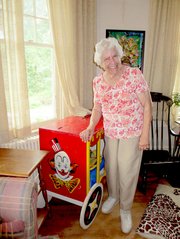Pat Price calls her west-facing yard her “heaven-on-earth.” The towering apple trees were just sticks when Price planted them in 1985. Photo by Donna Manz.
Pat Price lives in her girlhood home in Oakton. Not in the same place, but in the same house.
Price is 86 years old now. Her Oakton bonds go back to before 1850 when her great-grandmother took over as Oakton School’s first teacher. A great-grandfather fought in the Civil War. Her “people,” as she refers to her ancestors, have been in the Vienna-Oakton area for more than 150 years.
Price’s grandparents’ home, that of the Kenyons, was finished in 1916, and, for 70 years, it stood at the corner of Chainbridge Road and Miller Road, across from the Oakton Methodist Church. For several years, the house had no electricity and was served by an outhouse. Price was a little girl in the 1930s when the house had a pasture and the family raised pigs and chickens. Price remembers the big red barn which, she says, she loved to play in.
Price said her family fared better during the Depression than many others.
“We weren’t as affected because all the adults in the family kept jobs,” she said. “Four people were bringing in a paycheck every week with just me and my mother to support.”
After the death of her grandparents, the house was left to the three living children. Price’s mother and husband bought the house from the siblings who inherited it.
THE PAYNE STORE, a general store that sold everything, Price said, went up at the corner of Hunter Mill Road and Rt. 123 about 1936. Price said she loved the Paynes, who lived upstairs above the store.
“I was lonely as a little girl because we were so isolated, but I have lots of good memories,” Price says. “There weren’t many little girls living in Oakton in those days.”
Pat Kenyon Price remembers the “small town” of Vienna, going to the little library there and grocery shopping at the “Sanitary” store on Church Street.
“My favorite part of growing up in the Vienna-Oakton area was roller-skating down Rt. 123,” Price says. “There were so few cars, then. I rode my bike all over creation.”
Up through the early 1950s, there were still lots of farms in the Oakton area, Price recalls. Down Rt. 123 a little bit, toward Fairfax, was a fall turkey farm owned by the Craig family, that of Craig Movers.
In the early 1950s, the County started widening Rt. 123. World War II had ended a decade previously and post-war housing was popping up in the Vienna-Oakton area. “I guess that’s when things started rolling,” Price said. “I had a lot of friends on Hunter Mill Road in those days, but everything has just vanished.”
As a teenager, Price got her driver’s license at age 14. Two nights a week, Price—then still a Kenyon—and a girlfriend visited amputees at Walter Reed Hospital, playing cards with them, chatting. “To me, that was the greatest thing I’ve ever done in my life. It wasn’t much, but it was something.”
Along with girlfriends, Pat Kenyon the teenager took the Vienna trolley to go into Washington. “I loved taking the trolley to D.C.,” Price said. “It was so much fun. The trolley would shake us all over the place because it was a jiggly ride. We would go to the movies. In those days, the theatres had live bands that played before the movies started.”
After she graduated from Fairfax High School—there was no James Madison High School at that time—she worked in Washington.
[Kenyon] Price married at age 19, in 1946, and had five children, four of whom still live in the area. She herself was born in a D.C. hospital. “There were no hospitals around here then,” she says. Growing up “lonely,” she always knew she wanted a lot of children.
By the late 1970s, the area around the Hunter Mill corridor was blossoming. Businesses sprung up on the corners and bright light intruded on Price’s home. As much as a “major production” it was, the house was moved to its current location – just around the corner – in 1985.
“I have happy memories of the old days, but, I love that everything is so convenient nowadays,” Price says. “I have the best of two worlds where I am situated.
“To the east, I can walk to stores, to the church I’ve attended since I was a child [Oakton Methodist Church].” In 1998, the church celebrated its centennial and Price tap-danced to “Tea for Two.”
“To the west is my heaven-on-earth,” Price says, pointing out her windows toward the woodland surrounding her house. “The little deer come every night and I just love seeing them. One of my favorite things in the world is our trees.”
THE HOME LOOKS similar to its earliest years. Most of the windows in the house are original, as are the wood floors. The yard, however, was born of the house’s new location. When the house was moved to its current location in 1985, the land was “strafed,” as Price refers to it. Since there was nothing but empty land, Price ordered two little apple trees that were just “sticks” when she planted them. Today, those apple trees tower over her property, having bore apples for more than 15 years. The spruce tree that she treasures was given to her mother, then living with Price, for Christmas 1993, by Price’s children. “The whole family got together to plant the little tree, and now it’s more than 25 feet tall.
“I love Oakton, the people, the trees, just everything, about Oakton.”


